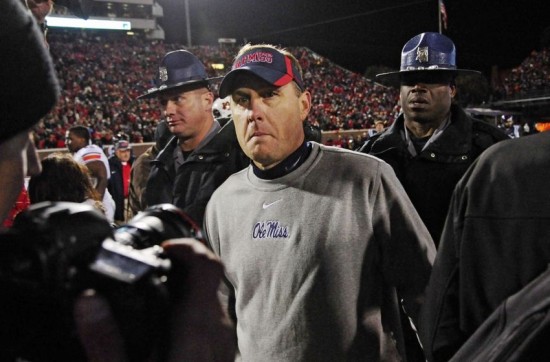It was a very clear theme and a very central question as the month of September came to an end: In the 2015 college football season, would teams unaccustomed to being the leaders and standard-bearers for their (power) conferences be able to handle the heat?
Will Utah be able to stand up to the fresh and more intense scrutiny it will receive as a result of crushing Oregon in Eugene?
Will Northwestern be able to maintain tunnel vision as the new “it” team in the Big Ten West? Saturday marked a very good start against Minnesota, but tougher tests await against Michigan, Iowa and Wisconsin.
In the SEC, plenty of teams are used to being a target, albeit for different lengths of time.
Texas A&M is the one school which really can’t be included in this discussion, due to its relative newcomer status in the league. Mississippi State was a target last season, and the Bulldogs didn’t hold up very well in November. The team was a marked group in 1999, one year after winning its only SEC West crown, and it actually did quite well, going 10-2, but Mississippi State couldn’t stay near the top of the West for long.
Alabama is quite practiced in the art of maintaining its place at the top of the SEC West. Auburn doesn’t necessarily string together great seasons, but the Tigers have been good at maxing out when they’ve had a shot at the brass ring. LSU, like Auburn, isn’t always at the very top of the SEC West, but when it is, it goes a long way.
Arkansas had a few moments in the limelight under Houston Nutt, but remained a volatile program which didn’t strike fear into the behemoths of the SEC and college football. The Hogs flourished just before Nick Saban came to Alabama, and they took advantage of a couple of seasons in which the SEC West was weak. Bobby Petrino took the program higher than it ever was under Nutt, but he couldn’t win the SEC West… and then he sabotaged the Arkansas athletic department.
This leaves Ole Miss.
The Rebels, since the SEC moved to split divisions in 1992, have never won an SEC West. They have never played in the Georgia Dome (or in Birmingham, site of the first two SEC title games) for their league championship. The 2003 Ole Miss team reached the Cotton Bowl under Eli Manning and coach David Cutcliffe. Other than that season, the Rebels just haven’t been able to carve out an identity as a top-tier SEC West program.
After winning in Alabama a few weeks ago, however, the table was freshly set, spread before Hugh Freeze’s team. The toughest road game on the schedule had been successfully navigated. The road trip to Auburn had already become a lot easier compared to preseason expectations. The LSU game is at home. So is the A&M game. Ole Miss had a chance to enter November with its boot on the SEC West’s throat.
The question was there, waiting to be answered, on Saturday night in The Swamp against the Florida Gators: How would this team — the least successful SEC West team in the 24-year SEC West era — handle the heat?
You got your answer.
Slow. Undisciplined. Unprepared. Unable to manage timeouts or points on a field-goal drive of nearly 10 minutes (when trailing by 25 midway through the third quarter).
Hitting. Blocking. Tackling. Angling off opposing receivers or ballcarriers.
Coaching. Tactics. Clock and timeout management.
Every which way, Ole Miss sputtered and stumbled and fumbled. Much should indeed be said about how great Florida was, but we go back to the central theme of the night:
Ole Miss freshly wore a target. The Rebels became a marked team, something they’ve rarely had to deal with over the past quarter of a century.
They certainly played like a team that wasn’t used to the newfound pressure of its place atop both polls and playoff projections.
How does a season become particularly clamorous, cluttered and crazy? When teams such as Ole Miss enter the top two and then play a fired-up opponent on the road.
We saw as much on Saturday night in Gainesville, and now the SEC’s margin for error has been reduced.
